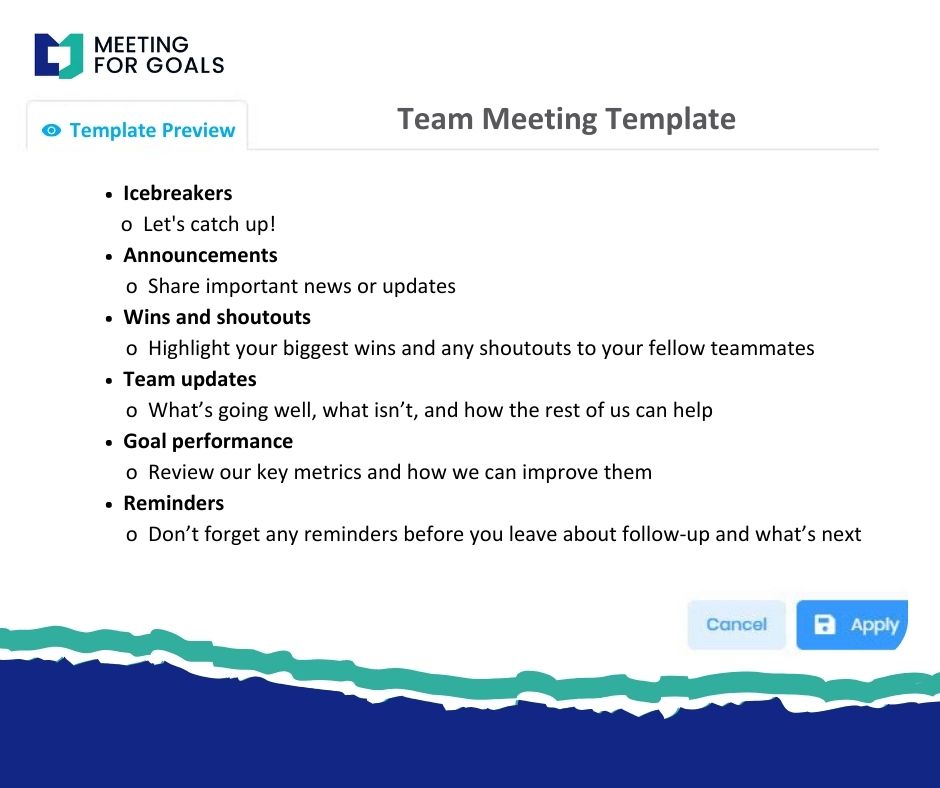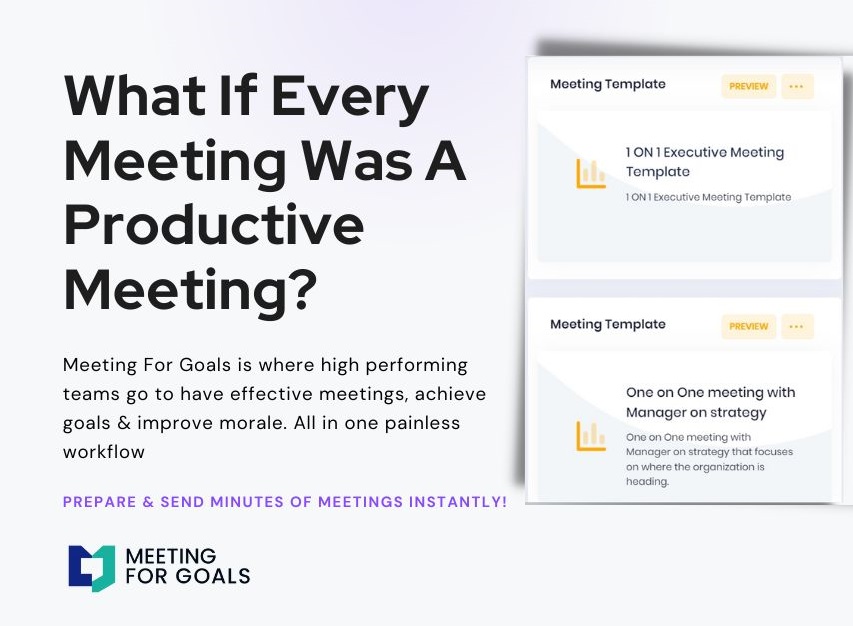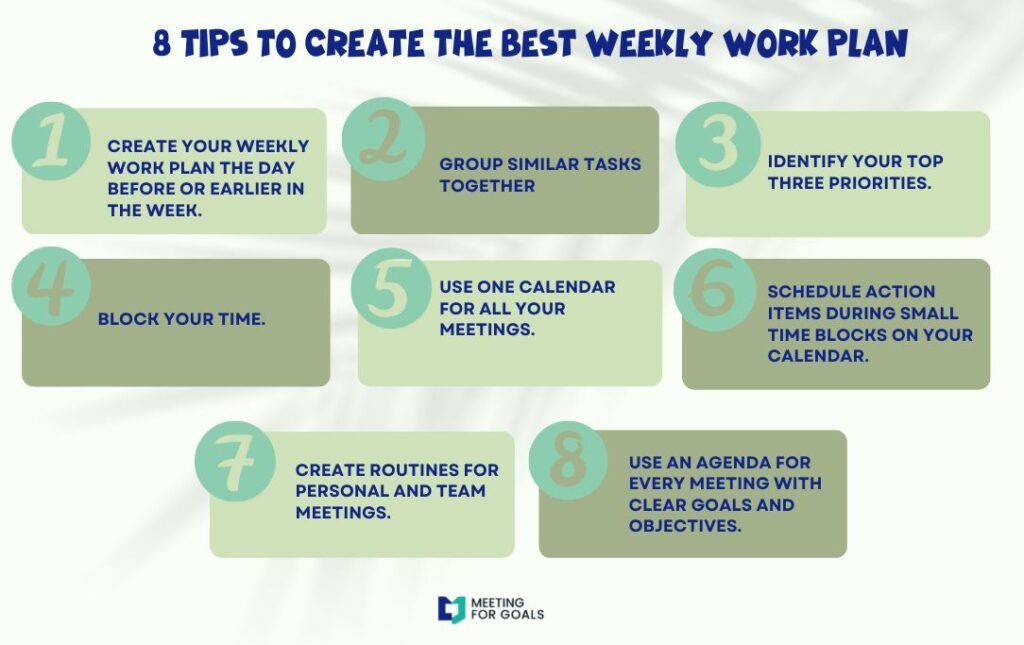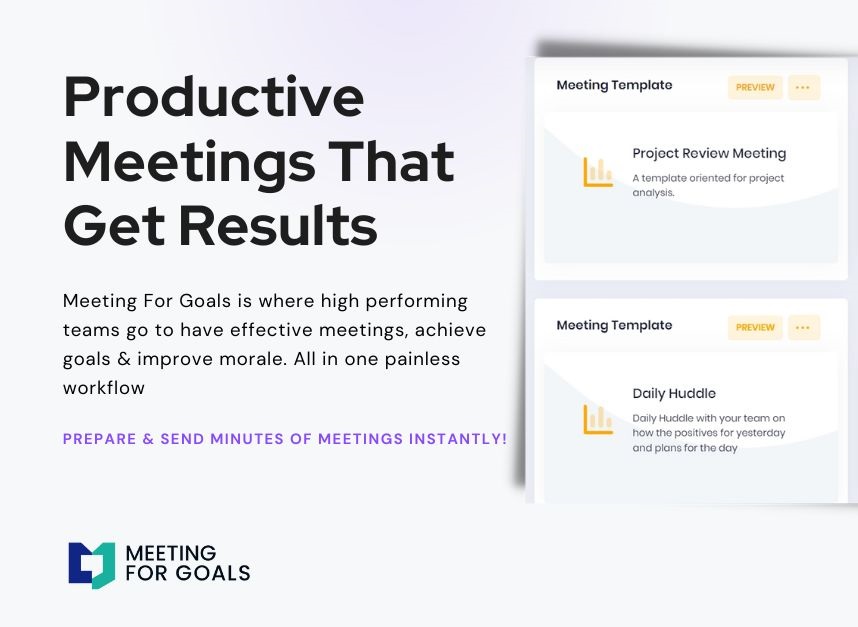Sample of Minutes of Meeting: A Complete Guide for High-Performing Teams
In today’s fast-paced business world, meetings are essential. They bring teams together, align priorities, and help move strategies forward. But here’s the catch—if those meetings aren’t documented properly, their impact often fades the moment everyone logs off or leaves the room. That’s where minutes of meeting come in.
Well-written meeting minutes serve as a reliable record of what was discussed, what decisions were made, and who’s responsible for what. They’re not just notes—they’re your team’s roadmap for execution.
In this guide, we’ll walk you through everything you need to know about writing effective meeting minutes. We’ll also show you how Meeting For Goals can help you streamline the process and turn your meetings into powerful productivity tools.
Looking for a faster way to run productive meetings? Check out our free meeting templates or sign up now to start using Meeting For Goals.
I. Introduction
For high-performing teams, meetings aren’t just check-ins—they’re strategic moments that drive real progress. But the true value of a meeting is realized after it ends. That’s when decisions need to be acted on, tasks need to be tracked, and goals need to be met.
Without a proper record, even the most productive discussions can fall apart. That’s why taking minutes of meeting is so critical. Meeting minutes are written summaries of what happens in a meeting. They capture key points, decisions, and assigned action items. For leaders managing teams of 40 to 70 people, they’re essential tools for keeping everyone aligned and accountable.
At Meeting For Goals, we know how valuable your time is. Our meeting management software is designed to help leaders run shorter, more focused meetings—and keep everything organized in one place. From agenda creation to action item tracking, our platform simplifies every step.
In this guide, we’ll cover:
- What minutes of meeting are
- How to structure them effectively
- Best practices for writing them
- How Meeting For Goals can make the process easier
Whether you’re a Director, VP, or C-level executive, mastering meeting minutes can boost your team’s clarity, alignment, and performance.
2 Minute Video
Watch a 2 minute demo of our meeting management software in action
II. What Are Minutes of Meeting?
Minutes of meeting are official written records that summarize the key takeaways from a meeting. This includes decisions made, action items assigned, and major discussion points. Think of them as your team’s memory. They help ensure that nothing is forgotten and everyone knows what’s expected of them.
Why Are They Important?
- They clarify decisions and next steps.
- They hold people accountable.
- They help track progress over time.
- They reduce misunderstandings and miscommunication.
For executives leading large teams, minutes are especially useful. They provide a clear snapshot of what happened and what’s coming next, making it easier to lead with confidence.
Common Components of Meeting Minutes
Here’s what a well-crafted set of meeting minutes typically includes:
- Date and Time: When the meeting took place.
- Attendees and Absentees: Who was present and who wasn’t.
- Agenda Items: What topics were discussed.
- Key Decisions: Any resolutions, approvals, or conclusions reached.
- Action Items: Who’s responsible for what, and by when.
By documenting these elements, you create a clear and actionable summary that everyone can refer back to. Want to see how this looks in practice? Explore our ready-to-use meeting templates to get started.
Adding an Agenda
How to add an agenda instantly on Meeting For Goals
III. Structure of Minutes of Meeting
Structure matters. A well-organized format makes your meeting minutes easier to read, reference, and act on. Here’s a simple yet effective structure you can use:
- Heading
Start with the basics:
- Meeting Title: Q3 Sales Strategy Meeting
- Date: June 15, 2024
- Time: 10:00 AM – 11:30 AM
- Location: Zoom or Conference Room B
This helps identify the document quickly and provides context.
- Attendees List
List everyone who was present, along with their roles. Also, note any absentees.
Example:
- Attendees: John Smith (VP Sales), Sarah Lee (Director of Marketing), Mike Brown (Sales Manager)
- Absentees: Jane Doe (Excused)
- Agenda Overview
Summarize the main topics that were discussed.
Example:
- Review of Q2 sales performance
- Q3 sales targets
- Marketing support for Product X
- Discussion Points & Decisions
Under each agenda item, summarize the key points discussed and any decisions made.
Example:
- Q2 sales fell short by 8% due to delayed product launches.
- Decision: Focus on Product X for Q3 to boost recovery.
- Action Items
Clearly list out what needs to be done, by whom, and by when.
Example:
- Mike Brown to submit revised sales forecast by June 20.
- Sarah Lee to launch Product X campaign by July 1.
- Additional Notes
Include any follow-up meeting dates, unresolved issues, or other relevant info.
Tips for Better Structure
- Use bullet points for clarity.
- Keep sentences short and to the point.
- Avoid technical jargon.
- Maintain an objective tone.
Meeting For Goals makes this easy with built-in templates that follow this structure. You can even assign action items and link them to company goals—all in real time.
IV. Best Practices for Writing Effective Minutes
Writing good meeting minutes isn’t about capturing every word—it’s about capturing what matters. Here are some best practices to help you write clear, useful, and actionable meeting minutes:
- Prepare Ahead of Time
- Review the agenda beforehand.
- Set up your note-taking template.
- Know who’s attending and what topics will be discussed.
- Focus on What Counts
Don’t try to write everything down. Instead, focus on:
- Decisions made
- Key discussion points
- Action items and deadlines
- Open issues or concerns
- Stay Neutral
Write in a clear, objective tone. Avoid personal opinions. Instead of “Sarah was frustrated,” write “Sarah raised concerns about the timeline.”
- Use the Right Tools
Technology can make a big difference. With Meeting For Goals, you can:
- Take notes in real time
- Assign tasks on the spot
- Automatically link notes to agenda items
This saves time and ensures nothing gets lost.
- Distribute Minutes Quickly
Send the minutes within 24 hours. This keeps the momentum going and helps everyone stay on track.
- Store Minutes in One Place
Keep all your meeting notes centralized. This makes it easy to reference past decisions and track progress.
Want to explore more tools for effective meetings? Check out this comprehensive guide from Harvard Business Review on running effective meetings.
V. How Meeting For Goals Enhances Minute-Taking
Meeting For Goals isn’t just another meeting tool—it’s a complete platform for running productive, goal-driven meetings. Here’s how it helps with minute-taking:
- Built-In Agenda Integration
Create your meeting agenda right in the platform. You can:
- Add agenda items and time blocks
- Link each item to a specific goal or KPI
- Pre-define note sections for each topic
This keeps your meeting focused and aligned with your objectives.
- Customizable Templates
Use ready-made templates for different types of meetings—sales, leadership, project updates, and more. This ensures consistency across all your meetings, no matter who’s leading them.
- Real-Time Action Item Tracking
Assign tasks during the meeting, complete with deadlines and owners. You can:
- Track task completion
- Send automatic reminders
- View all action items in one dashboard
No more chasing updates or wondering who’s doing what.
- Centralized Documentation
All your meeting notes are stored in one place. You can:
- Search past meeting minutes
- Review decisions made
- Track goal progress over time
This makes it easy to stay organized and aligned.
Real-World Results
- A 60-person tech company reduced meeting time by 30% and doubled their action item follow-through using Meeting For Goals.
- A marketing agency improved cross-departmental coordination by linking meeting minutes to campaign milestones.
Want to see it in action? Sign up now and experience the difference for yourself.
VI. Common Mistakes to Avoid in Meeting Minutes
Even seasoned professionals can fall into common traps when writing meeting minutes. Here are a few to watch out for:
- Being Too Vague
Avoid general statements like “team discussed marketing.” Be specific: “Team reviewed Q3 marketing plan and agreed to allocate 40% of the budget to digital ads.”
- Missing Action Items
If you don’t clearly state what needs to be done, by whom, and by when, things will fall through the cracks.
- Writing Too Much
Minutes are not transcripts. Keep them concise and focused on outcomes.
- Delaying Distribution
If you wait too long to send out the minutes, people will forget what was discussed. Aim to distribute within 24 hours.
- Not Following a Consistent Format
Inconsistent formatting makes minutes harder to read and reference. Use a standard template to keep things uniform.
Meeting For Goals helps you avoid all of these issues by automating the process and keeping everything organized in one place.
VII. How to Get Started with Meeting For Goals
Ready to transform how your team runs meetings? Getting started with Meeting For Goals is simple:
- Sign up here to create your free account.
- Choose a meeting template or create your own.
- Set your agenda, invite your team, and start your meeting.
- Take notes, assign action items, and track everything in one place.
You’ll be amazed at how much time you save—and how much more your team gets done. Need inspiration? Browse our free library of meeting templates to jumpstart your next session.
VIII. Conclusion
Meeting minutes aren’t just paperwork—they’re strategic tools that drive clarity, accountability, and execution. For leaders managing fast-moving teams, mastering the art of minute-taking can be a game-changer.
Let’s recap:
- Minutes help capture key decisions, discussions, and action items.
- A clear structure makes them easy to read and reference.
- Best practices keep your notes focused and actionable.
- Meeting For Goals simplifies the whole process and keeps your team aligned.
If you’re ready to turn your meetings into strategic assets, it’s time to take the next step.
- 👉 Sign up now to start using Meeting For Goals and experience a smarter, faster way to manage meetings.
- 👉 Explore our free meeting templates to get started with proven formats that work.
- 👉 Learn more about how Meeting For Goals can help your team stay aligned and achieve more.




